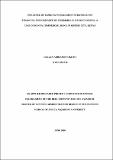Influence of banking management strategies on financial performance of Commercial Banks in Kenya: a case of Kenya Commercial Bank in Kisumu City, Kenya

View/
Date
2018-06Author
Okoto, Hellen Adhiambo
Type
ThesisLanguage
enMetadata
Show full item recordAbstract
The financial performance of commercial banks all over the world and in particular those from the developing economies such as Kenya are of critical importance not only for their own survival but also for the smooth economic interaction of the different segments of the market. This has led the commercial banks, particularly those in Kenya and mainly the tier one commercial banks to position themselves for strategic advantages both at the national and local level in-order to gain a competitive edge. It is in line with this fact that this study sought to determine the factors influencing the financial performance of Commercial Bank in Kenya with specific focus on KCB in Kisumu City. The study’s specific objectives was to determine the extent to which clientele Strategy, technology strategy, human resource strategy and working capital strategy influence financial performance of commercial banks in Kenya. The study was conducted through a descriptive survey design. Mainly in the 4 branches of KCB Bank in Kisumu City; specifically KCB Kisumu Main branch, KCB United Mall, KCB Kisumu West and KCB Kisumu Airport Branch. The target population was all the 102 employees of KCB Bank Ltd. spread across the four branches in Kisumu City. Stratified random sampling was used to select respondents and the sample size was 81 respondents. Structured questionnaires was used to collect primary data from respondents while secondary data was obtained from KCB Bank annual financial records. Data analysis for all objectives was done using descriptive statistics. Multiple regression analysis was used to show the causal relationship between the independent variables and the dependent variable. The findings are that the mean response rate on the effect of clientele strategies on bank performance is 4.00. This means that a greater number of respondents agree that the clientele strategies employed by the four branches of KCB in Kisumu City have an effect on the bank’s overall performance. The study also found out that the mean response rate on the effect of technological strategies on bank performance is 4.00. This means that a greater number of respondents agree that the technological strategies have an effect on the bank’s overall performance. Human resource strategy had a mean of 3.00 meaning that it had a moderate effect on financial performance of KCB Bank Ltd. Finally, the study discovered that a working capital strategy also has a moderate effect on the financial performance of the banks, as indicated by a mean of 3.00, coded as moderate. The study also found that Clientele Strategies, Technology Strategy, Human Resource Strategy and Financial Strategy explain up to 59% (R2 =0.59) of variance in the outcome of ROA which was statistically significant (p = .046 < .05) while also explaining 65% (R2 =0.65) of variance in the outcome of ROI which was statistically significant (p = .006 < .05).These findings are expected to benefit banking institutions in Kenya as they will act as a guide in the formulation of strategies and initiatives by bank managers and boards in order to improve on the financial performance of the commercial banks. The study might also help the regulatory authorities such as the Central Bank of Kenya in formulating appropriate policies and regulatory framework for the improvement of the banking system for the country’s economic growth and development.
Publisher
Africa Nazarene University
Subject
Banking management strategiesFinancial performance
Commercial Banks--Kenya
Commercial Banks
